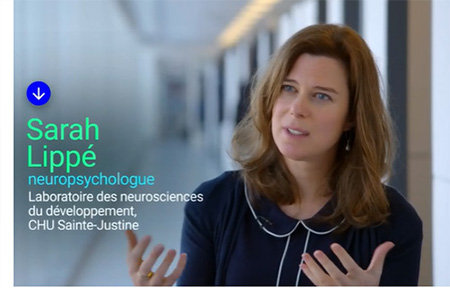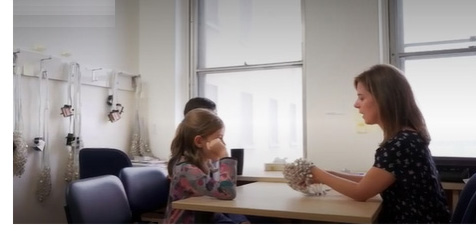The EEGLAB News #13
Sarah Lippé, Ph.D. Neuropsychologist
Full Professor, Psychology Department, University of Montreal
Director, Neuroscience of Early Development Lab (NED)
FRQ-S Senior Scientist, Sainte-Justine Hospital
“What happens at key moments in child development when pathologies sometimes occur that harm cerebral, cognitive, and emotional development?” Dr. Sarah Lippé, Full Professor of Psychology at the University of Montreal and FRQ-S Senior Scientist at Sainte-Justine Hospital, is determined to find answers. As Director of the multidisciplinary Neuroscience of Early Development Lab (NED) she studies the cerebral mechanisms involved in learning processes in infants and children. “I believe that many neurodevelopmental disorders exist because of an accumulation of prenatal and genetic risk factors,” she shares. “My research focuses on many of these possible risk factors.” She hopes the results of her studies will lead to the development of early screening methods and treatment options for children with neurodevelopmental disorders.
 "There are so many factors that influence child development,” she explains. “For the genetic aspect to affect neurocognition,” she continues, “often there is a mutation in a very important gene, or several mutations that have a general effect on the brain. It’s also possible that all genetic background has an influence when you accumulate the risk factors. I study these risk factors that, when combined, can affect brain development and increase a child’s risk of developing a neurodevelopmental disorder.” In other words, having one risk factor might not affect cognitive function, but when you accumulate many risk factors, you can end up having a very severe condition.
"There are so many factors that influence child development,” she explains. “For the genetic aspect to affect neurocognition,” she continues, “often there is a mutation in a very important gene, or several mutations that have a general effect on the brain. It’s also possible that all genetic background has an influence when you accumulate the risk factors. I study these risk factors that, when combined, can affect brain development and increase a child’s risk of developing a neurodevelopmental disorder.” In other words, having one risk factor might not affect cognitive function, but when you accumulate many risk factors, you can end up having a very severe condition.
 Dr. Lippé's studies include epilepsy, premature birth, leukemia, autism, intellectual disability, genes that affect brain development and maternal physiological and psychological conditions during pregnancy which may affect infant outcomes. She performs her work in an ideal location -- as an FRQ-S Senior Scientist at Sainte-Justine Hospital, the largest mother and child center in Canada. “It’s an incredible place, because it includes most pediatric specialties,” she shares enthusiastically. “I have the opportunity to study many risk factors in one place.” (Photo credit: Dr. Lippé, and NED, featured on Radio-Canada)
Dr. Lippé's studies include epilepsy, premature birth, leukemia, autism, intellectual disability, genes that affect brain development and maternal physiological and psychological conditions during pregnancy which may affect infant outcomes. She performs her work in an ideal location -- as an FRQ-S Senior Scientist at Sainte-Justine Hospital, the largest mother and child center in Canada. “It’s an incredible place, because it includes most pediatric specialties,” she shares enthusiastically. “I have the opportunity to study many risk factors in one place.” (Photo credit: Dr. Lippé, and NED, featured on Radio-Canada)
But with so many variables at play, estimating children’s outcomes can be extremely challenging. Dr. Lippé gives an example: “For infants who have one risk factor – such as having one seizure, or being born a few weeks earlier or having a copy number variation that affects a few base pairs – it can be difficult to measure the impact on brain development because the effect size is small or instances are so rare. In these cases, you need a huge data set.” Dr. Lippé strives to determine, “What is the real contribution of one risk factor over the others?’ It is hard to tell. Researchers, over the last ten years, have mostly studied one or two risk factors at a time to determine how each can affect the brain. Then, once we understand these factors better, we are able to study at the population level, how each can contribute to a developmental disorder.” This takes time and effort.
Dr. Lippé’s projects focus on environmental, as well as genetic, risk factors. She is eager to delve into a relatively new research track: Maternal depression during pregnancy. "I want to study how the interactions between infant and mother during pregnancy and early childhood can impact long term brain development and cognitive function.” This focus is especially important today. “During the pandemic,” she explains, “depression in mothers increased immensely: Up to 40% of mothers in Canada and other developed countries showed significant depressive symptoms during pregnancy.” Dr. Lippé wonders -- What are the effects of maternal depression on the developing fetus and infant, and what can be done to counter that effect? She hopes her research can help point the way.
 Upbringing and Education. Dr. Lippé was born and raised in Mont-Saint-Hilaire, Quebec, a small town close to Montreal. She grew up speaking mostly French, but was exposed to English often during her teenage years. (Photo: Mont-Saint-Hilaire, Quebec). Her interest in the brain began as an undergraduate at the University of Montreal. “During my bachelor’s degree, I was interested in the impact of psychological traits on brain functions, and the interaction between a neurological condition and psychological traits. For instance, I was interested in how stress, as measured by cortisol, could affect premature children, in addition to their prematurity. I wrote up the study as a bachelor’s student and even received small funding to do it. But I ended up not completing that project because I changed Universities and began a new project.”
Upbringing and Education. Dr. Lippé was born and raised in Mont-Saint-Hilaire, Quebec, a small town close to Montreal. She grew up speaking mostly French, but was exposed to English often during her teenage years. (Photo: Mont-Saint-Hilaire, Quebec). Her interest in the brain began as an undergraduate at the University of Montreal. “During my bachelor’s degree, I was interested in the impact of psychological traits on brain functions, and the interaction between a neurological condition and psychological traits. For instance, I was interested in how stress, as measured by cortisol, could affect premature children, in addition to their prematurity. I wrote up the study as a bachelor’s student and even received small funding to do it. But I ended up not completing that project because I changed Universities and began a new project.”
During her Ph.D. in clinical neuropsychology and research at the University of Montreal (graduated 2006), Dr. Lippé studied EEG signal in infants that experienced a febrile seizure or epilepsy. “We wanted to investigate whether there were particularities in the EEG signal that could explain the excitability in the brain. Not while they were having a seizure, but more generally.” Dr. Lippé’s aim was to be able to predict the seizure outcome (the neurological and cognitive outcomes) based on EEG.
The thought of using EEG results to predict behavioral outcome excited her. “Even back then, in the early 2000s, it was clear that there was a difference in high frequency and low frequency brain waves in infants with seizures. There were more lower frequencies and less higher frequencies at rest. The neuronal ensembles were already not behaving normally and they were not catching the developmental trajectory. We first saw this pattern in kids who had febrile seizures, but it is a pattern that we see now in children with a neurodevelopmental disorder. These infants often show a different pattern of density in the spectral domain."
After her Ph.D., Dr. Lippé worked for a few years in clinical pediatric neuropsychology, in a rehabilitation center with patients who had neurodevelopmental conditions, before completing post-doctorate degrees in neuroscience at the Atomic Energy Commission (France), where she used dMRI and fMRI to assess peculiarities of brain structures and functions of epileptic children.
EEGLAB. As a Ph.D. student, Dr. Lippé began searching for an additional measurement for the spectral analysis of her study with children who had neurofibromatosis. “Drs. Scott Makeig and Arno Delorme were just starting EEGLAB together,” Lippé recalls fondly. “I came across their research on the web, and my supervisor encouraged me to contact them to learn how EEGLAB works. He said, ‘If they accept, I will pay for your trip and your stay.’ So this is exactly what happened. I traveled to the Swartz Center for Cognitive Neuroscience (SCCN) in 2003 and stayed there for one month. It was great. I didn’t have a background in engineering or math like they do, but they were kind enough to show me the principles and how different things work. And sometimes there were little things that had to be developed or fixed, so they would create a script for it."
Dr. Lippé’s time at SCCN was an experience she will never forget. “It was extremely helpful. I worked with the data and EEGLAB for one month, creating all kinds of maps and looking at the data in all different ways. I learned so much during that month, that I was ready to basically make a career out of it!” she jokes, adding, “This was in addition to having a great month in San Diego! We went hiking, and I remember Scott’s son took me surfing. I was able to stand up on the board, but not for long!” She recalls going with SCCN colleagues to hike part of the Pacific Crest Trail (PCT) and meeting several hikers there; another time, she joined SCCN members on a trip to Joshua Tree in the Mohave desert.
EEGLAB has been invaluable to Dr. Lippé’s research. Her studies use non-invasive methods such as structural and functional neuroimaging, electrophysiology (EEG/MEG), and behavioral (eye tracking, neuropsychological tests) measures. “We probably use EEGLAB in 90% of our studies,” Dr. Lippé acknowledges. “We also use related plug-ins such as Fieldtrip, for some signal analysis.” The results have been impressive, hinting at the potential to impact early screening and treatment options for patients with neurodevelopmental disorders in the future. She eagerly summarizes some of the publications:
- In a study of three genetic syndromes associated with intellectual disability (Fragile X syndrome, Down syndrome, tuberous sclerosis complex), her team found that each syndrome affected brain activity, but the pattern of the brain signal was not the same. There were specificities and distinctiveness of ERP and RS brain responses between the syndromes. (Côté, et al, 2021 and critique: Hollander E and Uzunova G, 2022)
- In another recent paper, Dr. Lippé and her team studied the repetition effect (a decrease in the brain response for each repetition of the same thing) and change detection response (a different pattern of response when there is a change). They found that these responses exist very early in infants, and that they evolve with age. The results also suggest that the “repetition effects and change detection response vary according to adaptive skills displayed by infants during the first year of life, demonstrating their predictive value for neurodevelopment.” (Deguire et al, 2022 and López-Arango et al, 2021)
 EEG as an Outcome Measure. Dr. Lippé believes that EEG can be an important indicator for an underlying disorder, as well as a nice outcome measure for treatment. “We can test whether an intervention is beneficial to brain development by looking at the EEG signal,” Dr. Lippé eagerly shares. She is leading the EEG investigation of several trials to determine if taking a prescribed medication will increase and improve EEG signal. “We can ask, ‘Does this treatment show benefit in the EEG activity?’ Because EEG activity is a surrogate of brain functioning, and eventually behavior, as well.” She continues, “I believe that, although we measure aspects that are quite low level, if the brain signal improves, even for very simple things, the general outcome should improve, as well. We can test all kinds of interventions using EEG, to determine if those interventions are beneficial to brain development.” (Photo credit: Radio-Canada)
EEG as an Outcome Measure. Dr. Lippé believes that EEG can be an important indicator for an underlying disorder, as well as a nice outcome measure for treatment. “We can test whether an intervention is beneficial to brain development by looking at the EEG signal,” Dr. Lippé eagerly shares. She is leading the EEG investigation of several trials to determine if taking a prescribed medication will increase and improve EEG signal. “We can ask, ‘Does this treatment show benefit in the EEG activity?’ Because EEG activity is a surrogate of brain functioning, and eventually behavior, as well.” She continues, “I believe that, although we measure aspects that are quite low level, if the brain signal improves, even for very simple things, the general outcome should improve, as well. We can test all kinds of interventions using EEG, to determine if those interventions are beneficial to brain development.” (Photo credit: Radio-Canada)
“Sometimes,” she continues, “it is difficult to show that an intervention has an effect, when you choose one primary outcome measure, which is the design of a clinical trial currently. But if you show that there is an effect on brain function (using EEG), then that is a really good start. You don’t have to discard this treatment or intervention completely. You may just want to investigate further with other measures, or longer term, if it is finally beneficial.” Dr. Lippé offers an example – their proof of concept study on children with neurofibromatosis type 1, a genetic disorder that causes tumors to form on nerve tissue. “We’ve shown that Ritalin, a psychostimulant, is beneficial to the synchronized brain response,” she shares enthusiastically of their paper that was recently published in the Journal of Neurodevelopmental Disorders (Lalancette et al, 2022). “The other clinical trials are all currently in progress. I am eager to see the results!”
The Future. Dr. Lippé is passionate about her research and looks forward to exciting future discoveries. Her lab has already accomplished so much – it is among the very first to propose EEG as an outcome measure in international and national clinical trials, she and her lab are busy with many ongoing projects, and she is leading national and international initiatives on infant EEG, aimed at creating a normative database to understand EEG signals maturation and to create a clinical tool for infant brain signal assessments. (is this correct? I read on a website) She also participates on a committee with Drs. Makeig and Delorme called the Global Brain Consortium (GBC), a Canada-based, diverse network of brain researchers, clinicians, and institutions focused on building collaborative relationships among health researchers worldwide.
Dr. Lippé has a vision for her future. One of her goals is to perform more studies in a naturalistic setting: “I would like to study the interaction of infants and others using EEG in a naturalistic (or as we say in French, ‘ecological’) setting. Some people perform more naturalistic studies with infants, but not as frequently using EEG. I would like to have EEGLAB toolboxes adapted so that I could continue to use the same tools with those kinds of experiments.” She is excited about a recent project that studies stress in mothers and infants. “We are currently collaborating with a nursing colleague, to see whether more skin-to-skin contact between mother and premature infant during a difficult birth can reduce stress for both and improve outcomes. Does this skin-to-skin contact also show benefit in the EEG activity?” She pauses, then adds with a laugh: “It’s funny because this project involves that same study I wrote up from my bachelor’s studies that I never had the chance to complete. Investigating stress in premature infants in the NICU. We actually just received funding to do this project – about 20 years after I first wrote up the study!”
While some things have come full circle, Dr. Lippé remains steadfast in moving the field forward. She envisions a future where EEG becomes a clinical tool for neurodevelopmental disorders. “If a pediatrician has concerns about a child, sometimes it’s difficult to know if it is something the parents should be concerned about or not. In those cases, maybe an EEG could help,” she imagines. “Right now, we have to wait until the behaviors show, and then it can be more difficult to treat.” If we had the ability to detect things early in the brain, she believes, we might be able to offer interventions and support to children earlier. This could lead to better outcomes. “We’re a long way from using EEG as a clinical tool, because there is a lot of (EEG?) variability in the general population. But I think this approach could be very useful in the future.” (Photo credit: Radio-Canada)
Being the mother of a ten-year-old daughter has helped Dr. Lippé remain sensitive to important questions and paths of investigation. “I sometimes ask myself different questions than other researchers would,” Dr. Lippé admits, “because I observe things in my daughter. In fact, I did some of my studies really to answer those questions!” For her, and thankfully for many other families looking for answers.
R. Weistrop, September 2022
Publications
Lalancette, E., Charlebois-Poirier, AR., Agbogba, K. et al. Steady-state visual evoked potentials in children with neurofibromatosis type 1: associations with behavioral rating scales and impact of psychostimulant medication. J Neurodevelop Disord 14, 42 (2022). https://doi.org/10.1186/s11689-022-09452-y
Deguire F, López-Arango G, Knoth IS, MSc, Côté V, Agbogba K, Sarah Lippé S. (2022) Developmental course of the repetition effect and change detection responses from infancy through childhood: a longitudinal study. Cerebral Cortex (2022), bhac027, https://doi.org/10.1093/cercor/bhac027
López-Arango G, Deguire F, Côté V, Barlaam F, Agbogba K, Knoth IS, Lippé S. (2021) Infant repetition effects and change detection: Are they related to adaptive skills? Eur J Neurosci. 2021 Nov;54(9):7193-7213. doi: 10.1111/ejn.15475. Epub 2021 Oct 13. PMID: 34585451.
Côté V, Lalancette E, Knoth IS, Côté L, Agbogba K, Vannasing P, Major P, Barlaam F, Michaud J, Lippé S. (2021) Distinct patterns of repetition suppression in Fragile X syndrome, down syndrome, tuberous sclerosis complex and mutations in SYNGAP1. Brain Research, Volume 1751, 15 January 2021, 147205. https://doi.org/10.1016/j.brainres.2020.147205